|
|
|
Sort Order |
|
|
|
Items / Page
|
|
|
|
|
|
|
| Srl | Item |
| 1 |
ID:
086162
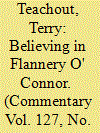

|
|
|
|
|
| Publication |
2009.
|
| Summary/Abstract |
In 1952, the landscape of American fiction was dominated by a group of literary celebrities who had published their first novels after or near the end of World War II.James Baldwin, Saul Bellow, Truman Capote, Ralph Ellison, Norman Mailer, J.D. Salinger,Gore Vidal: these were the up-and-comers about whom everyone was talking in the days when serious fiction still mattered to the educated public, the ones who were expected to do great things.
|
|
|
|
|
|
|
|
|
|
|
|
|
|
|
|
| 2 |
ID:
093228
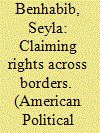

|
|
|
|
|
| Publication |
2009.
|
| Summary/Abstract |
The status of international law and transnational legal agreements with respect to the sovereignty claims of liberal democracies has become a highly contentious theoretical and political issue. Although recent European discussions focus on global constitutionalism, there is increasing reticence on the part of many that prospects of a world constitution are neither desirable nor salutary. This article more closely considers criticisms of these legal transformations by distinguishing the nationalist from democratic sovereigntiste positions, and both, from diagnoses that see the universalization of human rights norms either as the Trojan horse of a global empire or as neocolonialist intentions to assert imperial control over the world. These critics ignore "the jurisgenerativity of law." Although democratic sovereigntistes are wrong in minimizing how human rights norms improve democratic self-rule; global constitutionalists are also wrong in minimizing the extent to which cosmopolitan norms require local contextualization, interpretation, and vernacularization by self-governing peoples.
|
|
|
|
|
|
|
|
|
|
|
|
|
|
|
|
| 3 |
ID:
098878
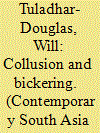

|
|
|
|
|
| Publication |
2010.
|
| Summary/Abstract |
By considering bickering, gossip and similar artful kinds of talk that reproduce social categories in a central Himalayan town, it is possible to see that participants in such talk collude in constructing a social landscape that grounds the relational distinctions foregrounded in those conversations. Following on from discussions that suggest anthropology of the environment must consider other social relations, here it is proposed that the environment is inescapably part of relational social distinctions. Collusion in the production of such shared landscapes, it is argued, is a key aspect of achieving ordinary life and, in certain contexts, can become the basis for resistance to the imposition of unwanted categorical distinctions.
|
|
|
|
|
|
|
|
|
|
|
|
|
|
|
|
| 4 |
ID:
097212
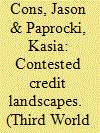

|
|
|
| 5 |
ID:
080576
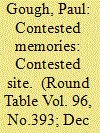

|
|
|
|
|
| Publication |
2007.
|
| Summary/Abstract |
The Beaumont Hamel Newfoundland Memorial is a 16.5 hectare (40 acre) tract of preserved battleground dedicated primarily to the memory of the 1st Newfoundland Regiment, who suffered an extremely high percentage of casualties during the first day of the Battle of the Somme in July 1916. Beaumont Hamel Memorial is a complex landscape of commemoration where Newfoundland, Canadian, Scottish and British imperial associations compete for prominence. A previous paper argued that those who chose the site of the Park, and subsequently reordered its topography, helped to contrive a particular historical narrative that prioritized certain memories over others (Gough, 2004). This argument focused on the premeditated redesign of the 'park' after the Great War, and then again in the early 1960s. Since the publication of the paper the soaring popularity of battlefield tours and visits has placed an intolerable strain on the very land that many regard as sacred and hallowed. A land that took decades to recover and reclaim from violation is now being threatened again both by developers and by crowds of tourists. As a result, measures have been taken to restrict access and control roaming rights. This paper will revisit the original arguments and examine the many tensions that have arisen in one of the most popular destinations on the old battle front. Reflecting on the recent dispute, the paper will explore issues of historical accuracy, topographical legibility, freedom of access, and assumed ownership. It will also try to understand the recent disputes as examples of borrowed 'entitlement' and a resistance (by some British visitors) to recognizing the historic value of Canadian (or more specifically, Newfoundland) heritage.
|
|
|
|
|
|
|
|
|
|
|
|
|
|
|
|
| 6 |
ID:
131924
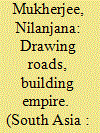

|
|
|
|
|
| Publication |
2014.
|
| Summary/Abstract |
Studies of colonial travel and mobility reveal how spaces are constructed through practices which select and link sites together, drawing fresh itineraries and re-organising places. A series of lithographic sketches published in 1830 as Sketches of the New Road in a Journey from Calcutta to Gyah, drawn by Charles D'Oyly (1781-1845) on his journey from Calcutta to Gaya, captures the tacit colonial imbrication of notions of travel, circulation, landscape and spatial production. An officer posted in various capacities at various places in eastern India in the early part of the nineteenth century, D'Oyly was a prolific amateur painter who sketched and painted different landscapes across the region. His Sketches holds a special significance as his pictures capture and freeze glimpses of a newly-constructed colonial road stretching across the countryside. D'Oyly's plates were intended to celebrate the new colonial circuit as a form of public works, drawing attention away from the urban epicentre of colonial Calcutta. I read this construction as a kind of spatial practice whereby a fresh idea of space emerges through these new operations, supplanting that of pre-colonial India.
|
|
|
|
|
|
|
|
|
|
|
|
|
|
|
|
| 7 |
ID:
112474
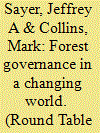

|
|
|
|
|
| Publication |
2012.
|
| Summary/Abstract |
There has been intense international debate on the governance of forests, in particular tropical forests. This has been driven by contrasting pressures from conservation and human rights groups, respectively calling for global values to prevail so as to protect biodiversity and reduce climate change, or for freedom of choice that empowers local people with the right to manage their own forests. Both sides have condemned irresponsible behaviour by forest officials and political actors, and highlighted the harmful impacts of disregard for the law. However, these normative approaches to forest governance have coincided with a fundamental re-examination of the objectives that societies have for their forest resources. The debate is not only about legality, but also about the legitimacy of forest laws and institutions. This review explores the divergence of views on long-term goals for forests and the implications for their governance. It emphasises that the real challenge is to reconcile the management of forests for values that accrue at different spatial and temporal scales. Forest governance needs to adapt, moving away from a framework based upon the neatly defined boundaries beloved of international organisations and treaties, and submitting to a constant process of adaptation and improvisation at a more local scale. The challenge is to find ways to aggregate such approaches into something that recognisably addresses the global values of forests and forest landscapes. Commonwealth countries have a wide range of forest conditions and are innovating with a range of governance options that provide lessons of potentially wide application.
|
|
|
|
|
|
|
|
|
|
|
|
|
|
|
|
| 8 |
ID:
152971
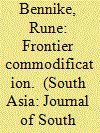

|
|
|
|
|
| Summary/Abstract |
In the contemporary global imagination, Darjeeling typically figures on two accounts: as a unique tourism site replete with colonial heritage and picturesque nature, and as the productive origin for some of the world's most exclusive teas. In this commodified and consumable form, Darjeeling is part of a wide array of frontier places that are increasingly incorporated into the circuits of global capitalism. In the present article, I argue that Darjeeling is in fact an early and emblematic example of such incorporation. By connecting emerging literature on the pre-colonial history of the area with a critical reading of colonial sources, I trace the shifts and erasures that enabled Darjeeling's commodification—a process that involved its transformation from a ‘wild’ Himalayan frontier into a speculative wasteland and, ultimately, into a picturesque and productive ‘summer place’. Reading through a range of material and representational interventions, I uncover the particular assemblage of government and capital that enabled this transformation and highlight its potential resonances with contemporary cases of frontier commodification in South Asia and beyond.
|
|
|
|
|
|
|
|
|
|
|
|
|
|
|
|
| 9 |
ID:
139245


|
|
|
|
|
| Summary/Abstract |
This article argues that Israeli documentary cinema represents Judea and Samaria as an oriental space. An analysis of some prominent films reveals common conventions used by filmmakers in the cinematic representations of the region. These conventions establish a series of distinctions between ‘here’ and ‘there’, such as domestic versus foreigner, familiarity versus strangeness, safety versus danger, and belonging versus alienation. The orientalization of Judea and Samaria is considered here as a rhetorical strategy that enables filmmakers to perform a cultural construction of the region as a colonized landscape.
|
|
|
|
|
|
|
|
|
|
|
|
|
|
|
|
| 10 |
ID:
141164
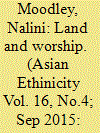

|
|
|
|
|
| Summary/Abstract |
This article, drawn from my doctoral study, focuses on the landscape paintings of two South African graduates of the former Indian institution, the University of Durban-Westville. The work is analysed through the lens of Hindu philosophy and Hindu ritualistic practice which views the earth as fundamental for survival and intrinsically linked to the cosmic order. This article presents the Hindu attachment to the land seen in the expansive imagery of Hindu deities located within serene landscapes resplendent in its attention to mythological and symbolic details. This attachment positions Hinduism as a guide to the exploration of the paintings. This article locates the work within the complex historical base of Indians in South Africa, and the impact it had on contemporary artists of Indian ancestry. While their art production addresses their conflating Indian/South Africanness, their paintings can be viewed as a veiled historiography of the Indian presence in South Africa.
|
|
|
|
|
|
|
|
|
|
|
|
|
|
|
|
| 11 |
ID:
095101
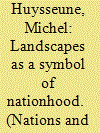

|
|
|
|
|
| Publication |
2010.
|
| Summary/Abstract |
While the dominant discourse of the Lega Nord, the party that proposes the independence of 'Padania', i.e. northern Italy, emphasises the region's economic success, contributions in the party literature on the Padanian landscape focus on the Alps. The Alps symbolise both the rootedness of the nation in tradition and ethnic identity and the intrinsic link between these traditions and modernity. They embody self-government of mountain communities and local traditions of political autonomy, but also appear as a protective bulwark against invasions of the Padanian lowlands. The focus on the Alps, an economically peripheral territory, is symptomatic of the reluctance to represent the environmental degradation caused by development in the lowlands. Contributions on the Alps, however, also reveal the tension between modernisation and the preservation of culture and territory and the need for new development models. Discussions on the Alps thus reveal the contradictions in the party's construction of a national identity based on modernity rooted in tradition.
|
|
|
|
|
|
|
|
|
|
|
|
|
|
|
|
| 12 |
ID:
061838
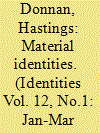

|
|
|
|
|
| Publication |
Jan-Mar 2005.
|
|
|
|
|
|
|
|
|
|
|
|
|
|
|
|
| 13 |
ID:
104008
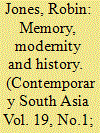

|
|
|
|
|
| Publication |
2011.
|
| Summary/Abstract |
This paper discusses the landscape garden of Lunuganga, Sri Lanka, designed by the architect Geoffrey Bawa for himself after 1948. It assesses this space as a site of memory and a location where modernity and history are negotiated. The present paper theorizes the making of Lunuganga in relation to the production of modernity in Sri Lanka and negotiation of the island's relationship to colonial and pre-colonial histories. The island of Sri Lanka has a long history of the development of cultural landscapes. Bawa's landscapes can be located within these traditions. Furthermore, the time he spent in Europe furnished him with an understanding of the picturesque landscape tradition. Lunuganga could be described as a site where these (colonial) histories and vernacular traditions re-staged or re-presented the modern in contemporary Sri Lanka. Bawa's landscapes can also be 'read' as 'sites of memory', where, although of the modern era, the past is recalled. The landscape of Lunuganga references negotiations between adoption of a universal modern, with its taint of colonial subjugation, the neglect of this troubled past and the pursuit of an uncomplex indigenism and, in so doing, intervenes in the production of modernity in Sri Lanka.
|
|
|
|
|
|
|
|
|
|
|
|
|
|
|
|
| 14 |
ID:
060702
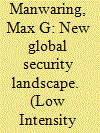

|
|
|
| 15 |
ID:
185949
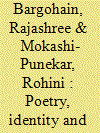

|
|
|
|
|
| Summary/Abstract |
This paper hopes to argue that the representations of and engagements with landscape by poets writing in English in Northeast India are embedded within the larger cultural and political contexts of the region. Indigenous communities across the world attach profound cultural, political, economic and spiritual significance to the territories they traditionally inhabit. It is for this reason that the preservation of their natural environment becomes crucial to the preservation of their cultural identities. Representations of the landscape by poets of Northeast India reflect the significance attached to and the intimate relationship shared with the natural environment by its diverse indigenous communities. The poets also display their awareness of the threats of ecological degradation faced by the region and the anxiety these threats have produced amongst the local population. The paper will try to understand the political dynamics behind the nostalgic associations ascribed to landscape in the poetry written in English in Northeast India.
|
|
|
|
|
|
|
|
|
|
|
|
|
|
|
|
| 16 |
ID:
099290
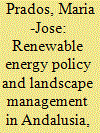

|
|
|
|
|
| Publication |
2010.
|
| Summary/Abstract |
Renewable energy has developed spectacularly in Spain since the European Union started a process of energy policy reform. A review of Spanish State legislation on renewable energies confirms that the success in installing renewable energy is attributable to public aid. Andalusia is one of the autonomous communities, which has simultaneously developed the legal framework and very successfully implemented the introduction of renewable power. When implementing the central government's policy, the Andalusian regional government prioritised increases in both surface cover by wind and solar plants (thermal and photovoltaic energy) and in the number of companies involved. However, this development of renewable energies took place without any proper integration into regional spatial and landscape planning. This paper explores renewable power implementation in Andalusia through regulatory measures put in place over the last decade to develop renewable energy systems and the way they can be managed alongside planning issues. The location of large-scale renewable plants has had consequences for territory in the socio-political context of renewable energy promotion. The main findings focus on renewable energy plant sprawl throughout rural areas in Andalusia with no clear effect on landscape management and no firm backing from the local population.
|
|
|
|
|
|
|
|
|
|
|
|
|
|
|
|
| 17 |
ID:
146771
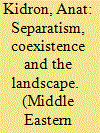

|
|
|
|
|
| Summary/Abstract |
Haifa was named a ‘mixed city’ by the British, who ruled Palestine from 1917 to 1948, in reference to the two national communities that inhabited the town. This definition was not neutral, and reflected the Brits aspirations to create national coexistence in Palestine among the diverse urban societies.
|
|
|
|
|
|
|
|
|
|
|
|
|
|
|
|
| 18 |
ID:
145860
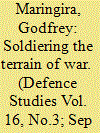

|
|
|
|
|
| Summary/Abstract |
The paper reveals how Zimbabwean soldiers who fought in the Democratic Republic of the Congo (1998–2002) were challenged by the terrain of war. While soldiers are trained to live and fight in dreadful wars, I argue that immersing oneself in the war terrain is neither mathematical nor calculative; rather, war tactics to be employed are defined by the context in which soldiers operate in. When soldiers reflect on and about the war, they unconsciously produce accounts that are often not completely heroic, but a life lived in fear as well an issue that they had never anticipated when they set out to war. A main finding of this study is that while these soldiers were deployed to fight against the rebels, they find difficulties in locating physical features from map reading to the ground, distinguishing the enemy from civilian people and deployed for days without eating a proper meal as well as seeing their fellow soldiers dying in the context of war. The paper provides a vantage point in which we can also understand that trained soldiers do not exert total power over war terrains, they are sometimes challenged by the war situation itself.
|
|
|
|
|
|
|
|
|
|
|
|
|
|
|
|
| 19 |
ID:
080918
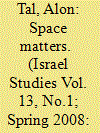

|
|
|
| 20 |
ID:
183712
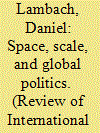

|
|
|
|
|
| Summary/Abstract |
Space matters for global politics but the treatment thereof in International Relations (IR) has been uneven. There is broad interest in spatial aspects across many research communities but only a nascent theoretical discussion and little cross-field communication. This article argues for a fuller engagement of IR scholars with sociospatial concepts and proposes a spatial approach to global politics based on four essential dimensions: a spatial ontology, the constructedness of space, a scalar perspective, and the interaction of materiality and ideas. As one possible way of integrating these aspects into a more specific concept, the article elaborates a framework of spatial practices and uses the example of Arctic Security research to illustrate the upsides of such a spatial approach for IR research.
|
|
|
|
|
|
|
|
|
|
|
|
|
|
|
|
|
|
|
|
|